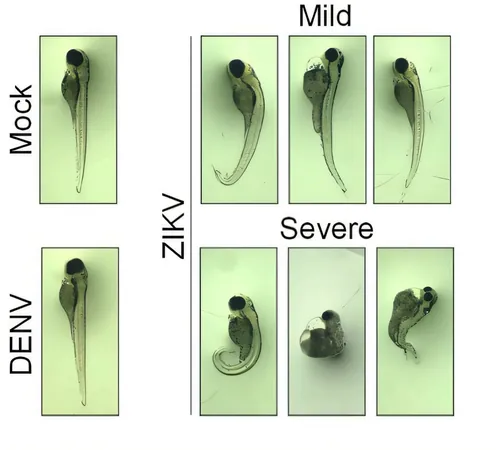
Unlocking the Secrets of Zika: How Zebrafish Reveal the Virus's Impact on Brain Development
2025-05-28
Author: Wei
The Zika Virus Crisis: A Growing Threat
The Zika virus (ZIKV) has emerged as a significant public health dilemma, notorious for causing severe developmental issues in fetuses during maternal infections. Among the most alarming consequences is microcephaly, a condition where newborns are born with abnormally small heads. Shockingly, as we currently stand, there are no approved vaccines or treatments available to combat this crippling disease, primarily due to a lack of understanding of its underlying mechanisms.
From Mice to Zebrafish: A Game-Changing Research Shift
Traditionally, mouse models have been used to study various infections, including ZIKV. However, these models face numerous drawbacks—high costs, ethical concerns, and technical challenges limit their scope. To circumvent these issues, a team from the Institut National de la Recherche Scientifique (INRS), including Professors Laurent Chatel-Chaix and Kessen Patten, turned to a groundbreaking alternative: zebrafish.
A Revolutionary Model Emerges
Working alongside Ph.D. student Aïcha Sow, the researchers developed a zebrafish model that examines ZIKV infection during the fish's early developmental stages. This innovative approach allows for the investigation at the levels of whole organisms, tissues, and even cells.
Why Zebrafish? A Unique Advantage
"Zebrafish are fascinating because their anatomical development closely resembles that of humans, but at an accelerated pace. In just 48 hours, we can observe organ formation, including the brain—a process that takes far longer in mice and humans," Sow reveals. Furthermore, the fish's optically transparent bodies and external fertilization facilitate real-time observation of their neurological development. Professor Laurent Chatel-Chaix lauds this model, highlighting it as a remarkable tool for examining disease aspects unattainable in mouse models.
Disturbing Discoveries: The Effects of Zika on Zebrafish
The team found that ZIKV inflicts alarming developmental defects in zebrafish larvae akin to human conditions: reduced head size, brain cell damage, and enlarged brain ventricles. They also uncovered specific neuronal defects and a loss of critical stem cells responsible for neuron generation.
A Breakthrough Protein Revelation
Sow's research unearthed a pivotal finding: expressing a single protein from the Zika virus in zebrafish mimics all the infection's harmful effects. This marks a significant milestone—the first instance of such a discovery in a vertebrate model.
Looking Ahead: Zebrafish as A Beacon of Hope
Professor Kessen Patten emphasizes the potential of zebrafish, noting their capacity for rapid and simultaneous drug testing—a feat unachievable in human studies. The transparency and swift development of these fish grant researchers a unique window into brain formation processes disrupted by the virus.
By utilizing this zebrafish model, scientists aim to delve further into the genetic pathways involved in the disease and enhance our understanding of its cellular mechanisms. Importantly, working with hundreds of larvae simultaneously offers promising avenues for more robust and trustworthy results.
A Bright Future in Zika Research
This pioneering research sets the stage for future breakthroughs in combatting the crippling impacts of Zika virus on brain development and may catalyze the discovery of effective treatments. With zebrafish leading the charge, hope glimmers on the horizon for those affected by this disease.




 Brasil (PT)
Brasil (PT)
 Canada (EN)
Canada (EN)
 Chile (ES)
Chile (ES)
 Česko (CS)
Česko (CS)
 대한민국 (KO)
대한민국 (KO)
 España (ES)
España (ES)
 France (FR)
France (FR)
 Hong Kong (EN)
Hong Kong (EN)
 Italia (IT)
Italia (IT)
 日本 (JA)
日本 (JA)
 Magyarország (HU)
Magyarország (HU)
 Norge (NO)
Norge (NO)
 Polska (PL)
Polska (PL)
 Schweiz (DE)
Schweiz (DE)
 Singapore (EN)
Singapore (EN)
 Sverige (SV)
Sverige (SV)
 Suomi (FI)
Suomi (FI)
 Türkiye (TR)
Türkiye (TR)
 الإمارات العربية المتحدة (AR)
الإمارات العربية المتحدة (AR)